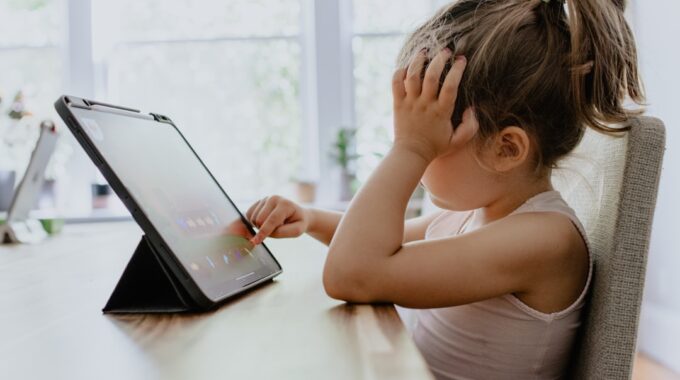Screens have become a global issue concerning all of us as parents and caregivers who…

What’s the Holistic Approach to My Child’s Eye Problems?
Holism, a Greek word meaning ‘whole’ or ‘total,’ forms the foundation of holistic eye care. This approach considers the whole person, rather than just focusing on the symptoms or conditions affecting the eyes.
The Role of the Ophthalmologist
An ophthalmologist’s primary role is to conduct regular and thorough eye examinations. These check-ups are crucial for children, as they not only assess vision issues but also detect signs of overall health conditions that can affect the eyes, such as allergies, juvenile rheumatoid arthritis, neurofibromatosis, Marfan syndrome, and diabetes.
Eye Care Practices at Home
Optimal eye health and the prevention of vision problems start with good habits established at home, involving the whole family.
Nutrition
Balanced Diet: Ensure your child eats a balanced diet rich in fruits, vegetables, whole grains, and proteins.
Essential Nutrients: Focus on foods high in vitamins A, C, and E, omega-3 fatty acids, minerals (zinc, selenium), and antioxidants. Recommended foods include leafy greens, carrots, sweet potatoes, fish, nuts, citrus fruits, and berries.
Hydration
Stay Hydrated: Encourage your child to drink plenty of water to maintain eye moisture.
Lifestyle
Outdoor Activities: Promote outdoor play to reduce the risk of myopia.
Sun Protection: Protect your child’s eyes from excessive sun exposure with UV-blocking sunglasses.
Adequate Sleep: Ensure your child gets enough sleep for eye repair and reducing eye strain.
Screen Time Management: Limit screen time and follow the 20-20-20 rule: every 20 minutes, look at something 20 feet away for at least 20 seconds. Encourage frequent blinking
Physical Activity
Regular Exercise: Physical activity improves blood circulation, which is beneficial for eye health.
Eye Exercises
Palming: Rub hands together to create warmth and place them over closed eyes for a few minutes to relax.
Focusing Exercise: Focus on a distant object for 10-15 seconds, then shift focus to a nearby object. Repeat several times.
Eye Rolling: Slowly roll eyes in a circular motion to improve flexibility and relieve tension.
Environmental Factors
Blue Light Reduction: Use blue light filters on digital devices or blue light-blocking glasses.
Proper Lighting: Ensure good lighting while reading or working to reduce eye strain.
Stress Management
Relaxation Techniques: Practice meditation, yoga, or deep-breathing exercises with your child to reduce stress, which can negatively impact eye health.
Eye Hygiene
Hand Washing: Teach your child to wash their hands regularly and avoid touching their eyes to prevent infections.
Avoid Eye Rubbing: Discourage rubbing eyes to prevent irritation and potential damage.
Contact Lens Care: Ensure contact lenses are used and maintained according to guidelines to avoid infections and discomfort.

Posture and Ergonomics
Good Posture: Ensure your child maintains good posture while reading or using digital devices to reduce neck and eye strain.
Ergonomic Furniture: Use furniture suitable for your child’s size to promote a comfortable reading and working environment.
Preventive Measures for Common Eye Complaints
Many eye complaints, such as ocular allergies, headaches, eye strain, and some visual problems, can be prevented or treated with a holistic approach.
Conclusion
By adopting these preventive measures, you can significantly reduce the risk of eye problems in children and help them maintain healthy vision throughout their lives. Regular check-ups, a healthy lifestyle, and good habits are key components in ensuring their long-term eye health. Remember, prevention is always better than cure.




This Post Has 0 Comments